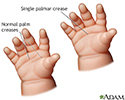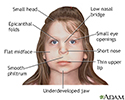Fetal alcohol syndrome
Alcohol in pregnancy; Alcohol-related birth defects; Fetal alcohol effects; FAS; Fetal alcohol spectrum disorders; Alcohol abuse - fetal alcohol; Alcoholism - fetal alcohol
Fetal alcohol syndrome (FAS) is growth, mental, and physical problems that may occur in a baby when a mother drinks alcohol during pregnancy.
Causes
Using alcohol during pregnancy can cause the same risks as using alcohol in general. But it poses extra risks to the unborn baby. When a pregnant woman drinks alcohol, it easily passes across the placenta to the fetus. Because of this, drinking alcohol can harm the unborn baby.
There is no "safe" level of alcohol use during pregnancy. Larger amounts of alcohol appear to increase the problems. Binge drinking is more harmful than drinking small amounts of alcohol.
Timing of alcohol use during pregnancy is also important. Drinking alcohol is likely most harmful during the first 3 months of pregnancy. But drinking alcohol any time during pregnancy can be harmful.
Symptoms
A baby with FAS may have the following symptoms:
- Poor growth while the baby is in the womb and after birth
- Decreased muscle tone and poor coordination
-
Delayed
developmental milestones
Developmental milestones
Developmental milestones are behaviors or physical skills seen in infants and children as they grow and develop. Rolling over, crawling, walking, an...
 ImageRead Article Now Book Mark Article
ImageRead Article Now Book Mark Article
Exams and Tests
A physical exam of the baby may show a heart murmur or other heart problems. A common defect is a hole in the wall that separates the right and left chambers of the heart.
Heart murmur
A heart murmur is a blowing, whooshing, or rasping sound heard during a heartbeat. The sound is caused by turbulent (rough) blood flow through the h...

There also may be problems with the face and bones. These may include:
- Narrow and small eyes
- Small head and upper jaw
- Smooth groove in the upper lip, smooth and thin upper lip
Tests that may done include:
- Blood alcohol level in pregnant women who show signs of being drunk (intoxicated)
- Brain imaging studies (CT or MRI) after the child is born
-
Pregnancy ultrasound
Pregnancy ultrasound
A pregnancy ultrasound is an imaging test that uses sound waves to create a picture of how a baby is developing in the womb. It is also used to chec...
 ImageRead Article Now Book Mark Article
ImageRead Article Now Book Mark Article
Treatment
Women who are pregnant or who are trying to get pregnant should not drink any amount of alcohol. Pregnant women with alcohol use disorder should join a rehabilitation program and be checked closely by a health care provider throughout pregnancy.
Support Groups
The following organizations may offer assistance:
- National Council on Alcoholism and Drug Dependency -- www.ncadd.org
- SAMHSA National Helpline -- 1-800-662-4357
The following organizations are good resources for information on alcoholism:
- Alcoholics Anonymous -- www.aa.org
- Al-Anon Family Groups -- www.al-anon.org
- National Institute on Alcohol Abuse and Alcoholism -- www.niaaa.nih.gov
- Substance Abuse and Mental Health Services Administration -- www.samhsa.gov
Outlook (Prognosis)
The outcome for infants with FAS varies. Almost none of these babies have normal brain development.
Infants and children with FAS have many different problems, which can be difficult to manage. Children do best if they are diagnosed early and referred to a team of providers who can work on educational and behavioral strategies that fit the child's needs.
When to Contact a Medical Professional
Call for an appointment with your provider if you are drinking alcohol regularly or heavily, and are finding it difficult to cut back or stop. Also, call if you are drinking alcohol in any amount while you are pregnant or trying to get pregnant.
Prevention
Avoiding alcohol during pregnancy prevents FAS. Counseling can help women who have already had a child with FAS.
Sexually active women who drink heavily should use birth control and control their drinking behaviors, or stop using alcohol before trying to get pregnant.
References
Carlo WA, Ambalavanan N. Metabolic disturbances. In: Kliegman RM, Stanton BF, St. Geme JW, Schor NF, eds. Nelson Textbook of Pediatrics . 20th ed. Philadelphia, PA: Elsevier; 2016:chap 106.
Falck AJ, Mooney SM, Bearer CF. Adverse exposures to the fetus. In: Martin RJ, Fanaroff AA, Walsh MC, eds. Fanaroff and Martin's Neonatal-Perinatal Medicine Diseases of the Fetus and Infant . 10th ed. Philadelphia, PA: Elsevier Saunders; 2015:chap 15.
Hoyme HE, Kalberg WO, Elliott AJ, et al. Updated clinical guidelines for diagnosing fetal alcohol spectrum disorders. Pediatrics . 2016;138(2). PMID: 27464676 www.ncbi.nlm.nih.gov/pubmed/27464676 .
Niebyl JR, Weber RJ, Briggs GG. Drugs and environmental agents in pregnancy and lactation: Teratology, epidemiology. In: Gabbe SG, Niebyl JR, Simpson JL, et al, eds. Obstetrics: Normal and Problem Pregnancies . 7th ed. Philadelphia, PA: Elsevier; 2017:chap 8.
-
Single palmar crease - illustration
There are typically two creases in the palm, but in some people, only one crease is present. A single palmar crease occurs in about 1 out of 30 people, but is also frequently associated with other conditions such as Down syndrome, Aarskog syndrome or fetal alcohol syndrome.
Single palmar crease
illustration
-
Fetal alcohol syndrome - illustration
Infants born to mothers who drink, even in modest amounts, may be born with fetal alcohol syndrome, which often consists of growth retardation, unusual facial features, and intellectual disability.
Fetal alcohol syndrome
illustration
-
Single palmar crease - illustration
There are typically two creases in the palm, but in some people, only one crease is present. A single palmar crease occurs in about 1 out of 30 people, but is also frequently associated with other conditions such as Down syndrome, Aarskog syndrome or fetal alcohol syndrome.
Single palmar crease
illustration
-
Fetal alcohol syndrome - illustration
Infants born to mothers who drink, even in modest amounts, may be born with fetal alcohol syndrome, which often consists of growth retardation, unusual facial features, and intellectual disability.
Fetal alcohol syndrome
illustration
-
Alcohol use disorders
(In-Depth)
-
Alcoholism
(Alt. Medicine)
Review Date: 8/31/2016
Reviewed By: Neil K. Kaneshiro, MD, MHA, Clinical Assistant Professor of Pediatrics, University of Washington School of Medicine, Seattle, WA. Also reviewed by David Zieve, MD, MHA, Isla Ogilvie, PhD, and the A.D.A.M. Editorial team.


